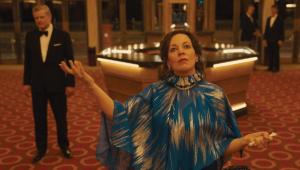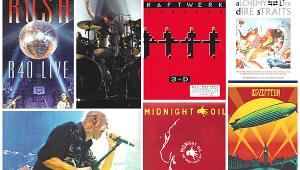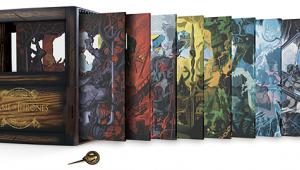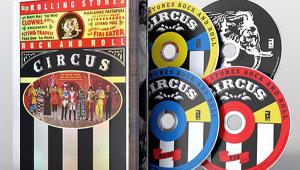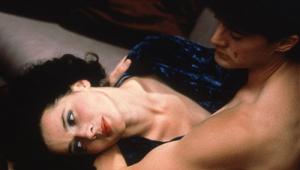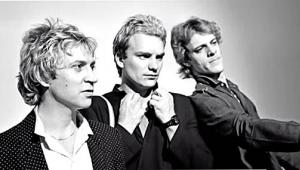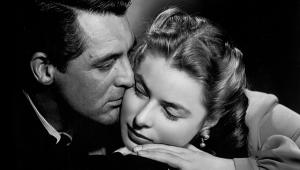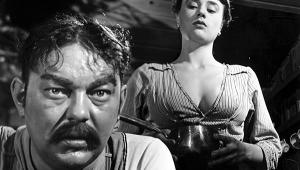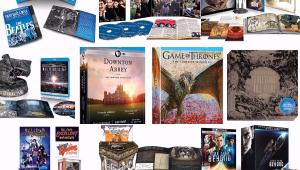Star Wars Trilogy
Mark Hamill, Harrison Ford, Carrie Fisher, Peter Cushing, Alec Guinness. Directed by George Lucas. 123 minutes. 1977/2004.
Picture ****
Sound ***
Film *** 1/2
Star Wars V: The Empire Strikes Back
Mark Hamill, Harrison Ford, Carrie Fisher, Billy Dee Williams. Directed by Irvin Kershner. 129 minutes. 1980/ 2004.
Picture ****
Sound ***
Film ****
Star Wars VI: Return of the Jedi
Mark Hamill, Harrison Ford, Carrie Fisher, Billy Dee Williams. Directed by Richard Marquand. 136 minutes. 1983/2004.
Picture *** 1/2
Sound ***
Film ***
All: Aspect ratio: 2.35:1 (anamorphic). THX-certified. Dolby 5.1 Surround EX (English), Dolby 2.0 Surround (English, French, Spanish). Four discs. 20th Century Fox Home Entertainment 2222341. PG. $69.98.
By all accounts, the original trilogy of Star Wars films was, for years, the most anticipated DVD set of all time. But the CEO of the Star Wars empire (pardon the expression), George Lucas, had steadfastly re-sisted putting it out. His stated intent: to delay the release until the current trilogy—The Phantom Menace, Attack of the Clones, and summer 2005's Revenge of the Sith—was complete. But for whatever reason, he changed his mind. Here, more than a year ahead of schedule, is the four-disc boxed set everyone has been waiting for.
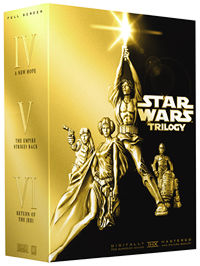 While I actually know people who haven't seen any of the Star Wars films, if you're reading this review you almost certainly aren't among them. But for Pete in Peoria and Bob in Boise, a quick recap will suffice. In Star Wars IV: A New Hope, a frustrated youth, Luke Skywalker (Mark Hamill), living on a remote planet in the Galactic Empire, comes across two droids (robots), C3PO and R2D2. R2 (as he comes to be called) is carrying an urgent message for an old hermit on the planet, Obi-Wan Kenobi (Alec Guinness). The message is from a Princess Leia (Carrie Fisher), warning of the Empire's plans for their new, planet-killing Death Star. The message also includes captured plans of the Death Star's defenses, plans that the rebellion against the Empire sorely needs. Luke and Obi-Wan, accompanied by the droids, the crew of the spaceship they hire, captain Han Solo (Harrison Ford) and his first mate, the Wookie Chewbacca, fly off in search of Leia, the Death Star, encounters with the villain of the saga, Darth Vader (voiced by James Earl Jones), adventure, triumph, and tragedy.
While I actually know people who haven't seen any of the Star Wars films, if you're reading this review you almost certainly aren't among them. But for Pete in Peoria and Bob in Boise, a quick recap will suffice. In Star Wars IV: A New Hope, a frustrated youth, Luke Skywalker (Mark Hamill), living on a remote planet in the Galactic Empire, comes across two droids (robots), C3PO and R2D2. R2 (as he comes to be called) is carrying an urgent message for an old hermit on the planet, Obi-Wan Kenobi (Alec Guinness). The message is from a Princess Leia (Carrie Fisher), warning of the Empire's plans for their new, planet-killing Death Star. The message also includes captured plans of the Death Star's defenses, plans that the rebellion against the Empire sorely needs. Luke and Obi-Wan, accompanied by the droids, the crew of the spaceship they hire, captain Han Solo (Harrison Ford) and his first mate, the Wookie Chewbacca, fly off in search of Leia, the Death Star, encounters with the villain of the saga, Darth Vader (voiced by James Earl Jones), adventure, triumph, and tragedy.
Star Wars IV: A New Hope was originally titled simply Star Wars, and was a self-contained story. But Lucas had originally written a much longer treatment, and when the first film was a smash hit, plans for the next installments fell into place. The titles of the next two chapters, The Empire Strikes Back and Return of the Jedi, pretty much tell you all you need to know before watching them.
But Lucas had even bigger plans. After Star Wars, he announced that there would be nine movies in the series. Star Wars, Empire, and Jedi would form the middle chapters—thus the renaming of Star Wars as Star Wars IV: A New Hope on that film's re-release in 1979 (fans were at first more puzzled by the designation IV than by rest of the name change).

But the completion of the, um, nonet, was put on the shelf for years. My father, who enjoyed the first three, wondered if he would live long enough to see the rest. He didn't, and some far younger fans were wondering if they would, either. Finally, with the release of Star Wars I: The Phantom Menace in 1999, it was decided that there would be six films rather than nine. Lucas, of course, could still change his mind, but he probably wants to live to see the end of the saga, too.
But it's the three classic films that concern us here. For most fans, these are the prime chapters in the film so far (only the most fawning fan would argue that Phantom Menace and Attack of the Clones are superior to them on anything but a technical level).
Star Wars I: A New Hope is a hoot. It's relatively shallow on an emotional level, and only a little better in character development—though the scene of Luke gazing longingly on the setting suns of Tatooine, as John Williams' now classic score swells in the background, is one of my favorite of the entire Star Wars saga. It tells us more about Luke than 20 pages of dialog. Star Wars (or A New Hope), brought a level of cheerful excitement back to films after the prevailing angst of the early 1970s. To paraphrase one of the commentators on the extra features, Star Wars arrived just when we needed it.
Jumping to the last of the three films for a moment, Star Wars VI: Return of the Jedi, is something of a mixed bag. Directed by Richard Marquand, it was well-edited, a step up from the earlier films technically, and no less exciting. But like many fans, I was—and still am—put off by a few elements. Han Solo's return from his fate in Episode V is too easy, and the "weapon" that the Emperor uses to torture Luke near the end of the film is a sci-fi cliché. Worst of all are those teddy-bear Ewoks. Oh, and we're supposed to believe that the fate of the entire Galactic Empire depends on the fate of one emperor and one battle. Unlikely. Perhaps the loose ends were to be tied up in those now-shelved final three chapters.
Like all armchair directors, I have my own ideas of how the final scenes of Jedi should have been edited: After the battle, cut immediately to the celebrations around the Empire. Then return to the celebration on Endor. Cut out the silly (and, with the changes made in these new editions, controversial) shot of the "ghosts." Move next to Luke at the funeral pyre, after which the camera rises to the sky shot with fireworks, the score soars, and . . . cut to end credits. In light of Lucas' recent comments that the entire saga is the story of Darth Vader, this sequence would make more sense. But George didn't ask me.
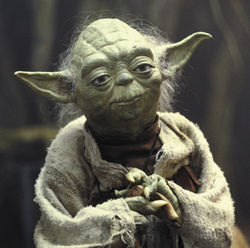 It's the middle of the original three films, The Empire Strikes Back, that's almost universally regarded as the best Star Wars film yet made. It's that and more, though not because its action sequences and technical prowess are better than the other films'; they aren't. But its characters are more thoroughly explored, its story is richer, its emotions far deeper than anything else from the Star Wars universe. And, most important, it has a stunning, bittersweet ending that works because we know there's more to come. The work of writers Leigh Brackett and Lawrence Kasdan and director Irvin Kershner has proven a tough act to follow. No other writing-directing team—Lucas included—has done as much to make Star Wars a classic series of films.
It's the middle of the original three films, The Empire Strikes Back, that's almost universally regarded as the best Star Wars film yet made. It's that and more, though not because its action sequences and technical prowess are better than the other films'; they aren't. But its characters are more thoroughly explored, its story is richer, its emotions far deeper than anything else from the Star Wars universe. And, most important, it has a stunning, bittersweet ending that works because we know there's more to come. The work of writers Leigh Brackett and Lawrence Kasdan and director Irvin Kershner has proven a tough act to follow. No other writing-directing team—Lucas included—has done as much to make Star Wars a classic series of films.
In recent years, George Lucas has tinkered with all three films for various re-releases. Because these early productions lacked modern special effects (though they were pretty special to those of us who saw them on the big screen in their initial runs), the changes were designed to make the transition to the more recent Star Wars episodes less jarring—and to realize Lucas' vision for the movies, a vision he could not fully realize in the original releases, for reasons technical and monetary.
In these new DVDs, even more changes have been made. Additional computer graphics have been added. Matte paintings have been replaced. Computer-animated characters enhance a few scenes (some of these were in the late–1990s re-releases). I don't want to give away too many of the changes here, but it's now clear that Han Solo does not shoot first in the Star Wars cantina scene, and a widely criticized scream from Luke at the climax of Empire is now history.
Some fans argue that the classic films, as originally presented, belong to them, not Lucas, and that such changes are tantamount to sacrilege. Others support Lucas' choices; he is the creator of the films, not the fans, and should have final say over any alterations.
After viewing these three "new" films, I have to come down on Lucas' side. While few of us felt that they were missing anything when we first saw them, they are now more epic in scope. But Lucas could quiet the classic fans by also making the original cuts available. I wouldn't be surprised to see him do so in the future, but for now, what we have on these DVDs are the updated versions.
And they are spectacular. The video transfers alone are worth the price. Lowry Digital Images did a heroic cleanup job on the films; on A New Hope alone they removed millions of specks of dirt and grime, while in some of the new shots they've had to add grain to match older effects. The telecine transfer was supervised by THX, and according to THX's Rick Dean, these finished DVDs look even better than the original theatrical releases.
Believe it. Projected on an 87-inch-wide screen, using an InFocus ScreenPlay 777 three-chip DLP projector, all three films looked amazing. A New Hope and Empire looked as if they were produced and distributed yesterday. The images are sharp, but without a trace of visible edge enhancement (a flaw that cripples the current release of Star Wars I: The Phantom Menace). The live-action shots of the actors are actually sharper than those in Star Wars II: Attack of the Clones (the latter was "filmed" with early high-definition digital video cameras). Colors are rich (the blue sky of Tatooine jumps off the screen), I could spot no digital artifacts, and there's not a trace of dirt anywhere. The images on Return of the Jedi are just a hair softer than in the other two films, but you'll notice that only in a direct comparison.

All three films have solid soundtracks. In general, the dynamics, while far from tame, seem just a little less explosive than in more recent films, and the music recording is a bit rough in places (Jedi sounds somewhat smoother). But the brass in John Williams' score makes you sit up and take notice, the dialog is always clear, and the effects are surprising. I suspect some enhancement here; while I've heard deeper bass on newer movies, the low end here is much more potent than I (distantly) recall from those early theatrical experiences, and the surrounds are far more active.
There has been some chatter on the Internet about flaws in the soundtrack of A New Hope. The first complaint involves swapped channels for the music in the surrounds. I heard this, but it's at such a low level—if your surrounds are properly balanced—that you're unlikely to hear it unless you move closer to the surrounds
and listen for it. There have also been complaints about dialog dropouts in the conversation between Governor Tarkin and Leia (The "foul stench" scene). I didn't hear a problem here at all, on two different systems. There has also been grumbling about the dialing-down of the music level in some action scenes. I noticed this too, but it didn't bother me.
Extras include commentary tracks for all three films: George Lucas, Carrie Fisher, special-effects guru Dennis Muren, and sound designer Ben Burtt on all three, joined by director Irvin Kershner on Empire. Disc 4 also includes several short subjects (one of them an interesting though not particularly revealing sneak look at 2005's Star Wars III: Revenge of the Sith), trailers, and a 21/2-hour documentary, Empire of Dreams: The Story of the Star Wars Trilogy. While marred slightly by a little too much gushing over Lucas, this feature-length piece is never less than absorbing. It will tell you almost everything you wanted to know about the movies and the film-industry politics involved in getting them made.
If you haven't already added this release to your DVD collection, do it now. Or put it in your letter to Santa.—TJN
- Log in or register to post comments
